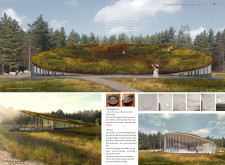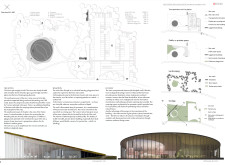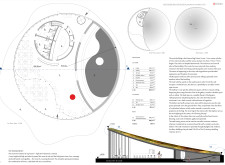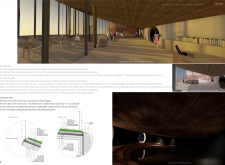5 key facts about this project
The visitor center at the Great Kemeri Bog is positioned within a unique natural habitat, designed to engage visitors with the surrounding landscape. The center serves as both an introduction to the bog and a space for exploration. The design emphasizes organic shapes that reflect the nuances of the swamp, inviting a connection between architecture and nature.
Concept and Design Intent
The design aims to prioritize sustainability and interaction with the environment. The site is divided into two main areas: one accommodates parking and camping, while the other contains the visitor center. This layout incorporates winding paths that guide visitors through the area, mimicking the natural forms found in the bog.
Structural Features
A key characteristic of the center is its dimpled roof structure. This feature not only enhances the building's appearance but also contributes to energy efficiency. The roof is designed for passive heating and cooling, helping to maintain a comfortable interior climate. Additionally, it allows natural light to filter in, creating a strong connection between the inside spaces and the outdoors.
Materiality
Materials used in the construction reflect the intent to merge with the environment. The interior ceilings utilize naturally grey wooden siding, while the walls are finished with stucco and paint. White polyurethane floors are chosen for their durability and practicality. These material choices support the overall design vision and ensure that the center remains functional for visitors.
Visitor Experience
The visitor center accommodates various activities, including educational programs and recreational opportunities. Within the center, different spaces are designated for learning, socializing, and relaxation. The dimpled roof also lends itself to being an outdoor amphitheater for community events. This thoughtful arrangement encourages interaction and allows visitors to engage with the ecological significance of the Kemeri Bog.
The design is anchored by the roof, which serves not only as a visual element but also focuses on drawing visitors into the experience of the landscape. Its presence reflects the themes of exploration and respect for the natural environment, inviting all who come to appreciate the richness of the bog.






















































